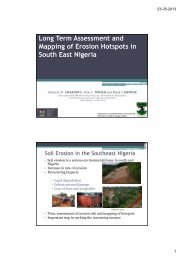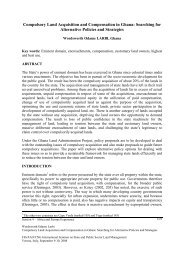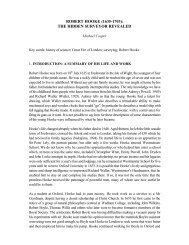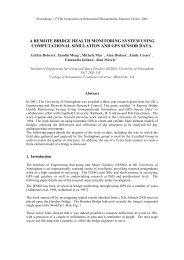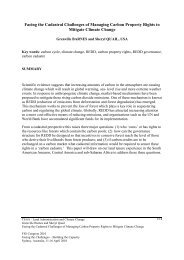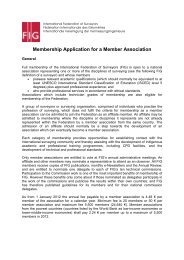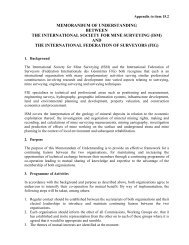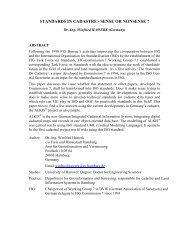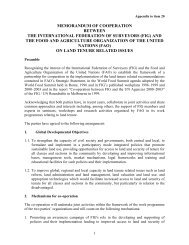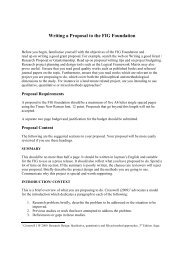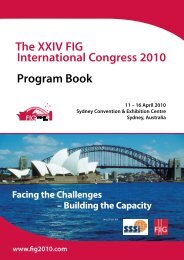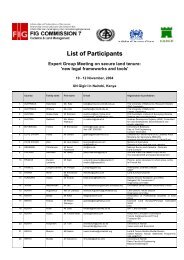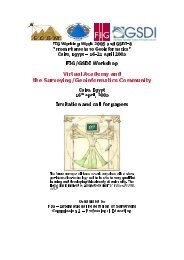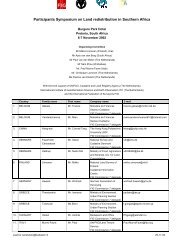Plane Based Free Stationing for Building Models - FIG
Plane Based Free Stationing for Building Models - FIG
Plane Based Free Stationing for Building Models - FIG
You also want an ePaper? Increase the reach of your titles
YUMPU automatically turns print PDFs into web optimized ePapers that Google loves.
1. INTRODUCTION<br />
TS09E - Engineering Surveying - Software, 5118<br />
Christian Manthe<br />
<strong>Plane</strong> <strong>Based</strong> <strong>Free</strong> <strong>Stationing</strong> <strong>for</strong> <strong>Building</strong> <strong>Models</strong><br />
<strong>FIG</strong> Working Week 2011<br />
Bridging the Gap between Cultures<br />
Marrakech, Morocco, 18-22 May 2011<br />
<strong>Plane</strong> <strong>Based</strong> <strong>Free</strong> <strong>Stationing</strong> <strong>for</strong> <strong>Building</strong> <strong>Models</strong><br />
Christian MANTHE, Germany<br />
If a building has been designed by an architect the 3D model is mostly given. In that case it<br />
can be used to create a 3D facility management system that has been derived from the given<br />
model. <strong>Based</strong> on that 3D model new possibilities can be explored in marketing, transparent<br />
management, navigation or planning of reconstruction processes. The task <strong>for</strong> surveyors is to<br />
determine deviations or the gap between the model and the real world with respect to a<br />
desired accuracy.<br />
The situation in the as-built segment is even more difficult. Of course, these facilities are<br />
managed without geometric models, but nevertheless it would be helpful to use only one<br />
dataset <strong>for</strong> all mentioned applications.<br />
When creating a 3D model of a building, different demands concerning its topology and<br />
geometry to create a useful model have to be satisfied. A useful model on one hand describes<br />
a dataset that allows the integration of new observations or where given model can be updated<br />
in terms of its geometry. On the other hand the model should use the topology of rooms as an<br />
interface to facility management software.<br />
2. A PLANE BASED BUILDING MODEL<br />
For the creation of a 3D model distance measurement devices can be used to virtually<br />
construct a building within CAD software. The derived 3D model does only contain<br />
geometric in<strong>for</strong>mation. Stochastic in<strong>for</strong>mation of the model can only be assumed globally<br />
with respect to the applied measurement devices but is only sufficient to answer simple tasks.<br />
The problem of this naive perspective is that the local precision is influenced by the order of<br />
how the model has been created which also falsifies the accuracy of the local geometries as<br />
well as the stochastic in<strong>for</strong>mation. The only current solution of how to check the derived<br />
CAD model is by carrying out control measurements.<br />
The best way to receive stochastic in<strong>for</strong>mation is by per<strong>for</strong>ming an adjustment where all<br />
measurements are used. The advantage of the adjustment is that the solution is independent of<br />
the order of the construction process of the CAD which opens the possibility to update the<br />
model geometry with new observations. To design functional relations identifiers <strong>for</strong> all<br />
entities have to be introduced to handle the redundant observations.<br />
By creating the functional model suitable unknowns has to be chosen. Because of the reduced<br />
number of unknowns and the characteristics of buildings, plane parameters were introduced to<br />
describe the functional model (Clemen, 2009). This approach separates geometric in<strong>for</strong>mation<br />
(plane parameters) from the topology (vertices, edges and faces), which allows updating<br />
processes of the geometry as a result of the adjustment.<br />
2/10



